First upon arriving we book a taxi to take us
to the Pakistan border for the sunset border closing ceremony. The
guide book describes the ceremony as Monty Python-esque. I wonder
how it could be possible that a perfectly serious government ceremony
could warrant such a description. We arrive near the border in
late afternoon and the crowd is just starting to swell on both sides of
the border. There is fresh popcorn and postcards for sale near
the bandstands blaring classical Indian music.
|
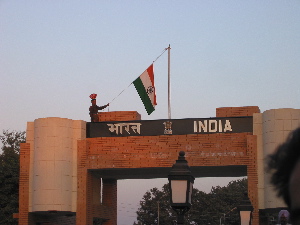 |
| The ceremony involves what looks like a game
of chicken between double-time, high-stepping, regal troops – Pakistani
and Indian. There is cheering and chanting from the crowd.
There is belligerant stomping and flag lowering. The locals
compare it to a good cricket match. But cricket metaphors are lost
on us. |
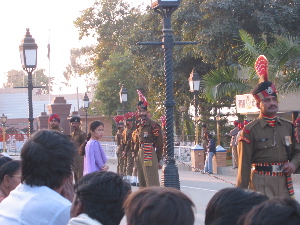 |
The next day we visit the Golden Temple.
It is spectacular. We don our headgear and remove our shoes
and wander around the pool. Sikh guards with spears or scimitars
patrol the grounds and ensure the rules are kept. After we get
over the nervousness of being surrounded by so many adherents of a
religion that urges willingness to protect the faith with arms if
necessary, we become quite comfortable in the absence of beggars or
hawking vendors.
|
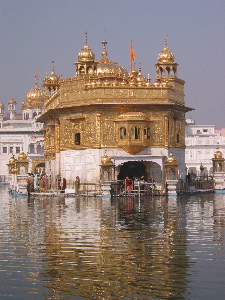 |
The beautiful melody of the Sikh scriptures
being sung over the loudspeakers is haunting. The marble tile is
shockingly cold on our feet in the shade, but toasty warm in the sun.
We meet a Sikh on pilgrimage from the UK who greets us cordially
and offers to answer any questions or assist us in any way. We
feel warmly at home here.
|
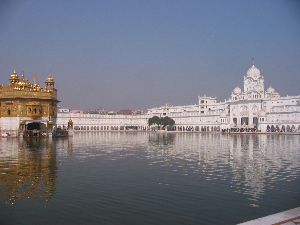 |
The Sikhs believe in a formless God and so
have no idols or sculpture. They also believe strongly in equality
which they encourage by offering a free meal for all to eat together.
This is contrary to Hindu custom where castes eat separately.
Here, a platoon of volunteers feeds 70,000 worshippers and
tourists a day. We eat sitting on the floor with about a hundred
others. The meal consists of chapati (flat bread) and black dhal
(spicy pea soup). Indians stare at us. As I was politely cleaning
my plate and planning my exit, I was served a second helping as big as
my first despite my best gestures indicating I was full. I kept
my eye on the seconds man from then on, and hurriedly finished before
he could come around again.
|
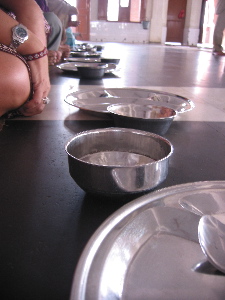 |
Here we are wearing our head coverings that
we hope are suitably respectful and don't cause suspicion from our
heavily armed hosts.
|
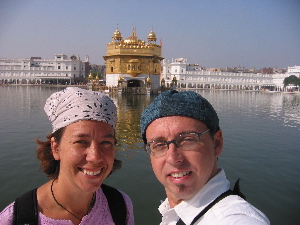 |
We walk around the bazaars of old Amritsar
trying to find a famous dhaba (kitchen). Luckily we started
looking early because it took us until dinner time before we found it.
We sit down to a fantastic meal of dhal, chapatis, chana masala,
palak paneer, and Pepsi. That's me taking my picture in the mirror.
|
 |
Next door is the kitchen.
|
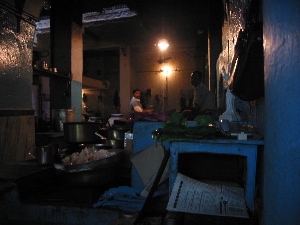 |
|
|
|
|















